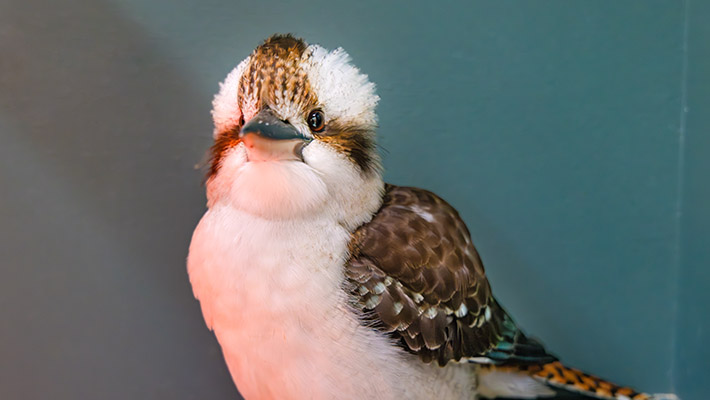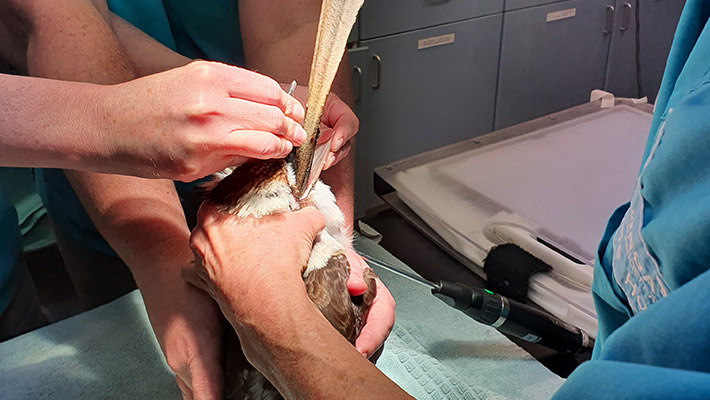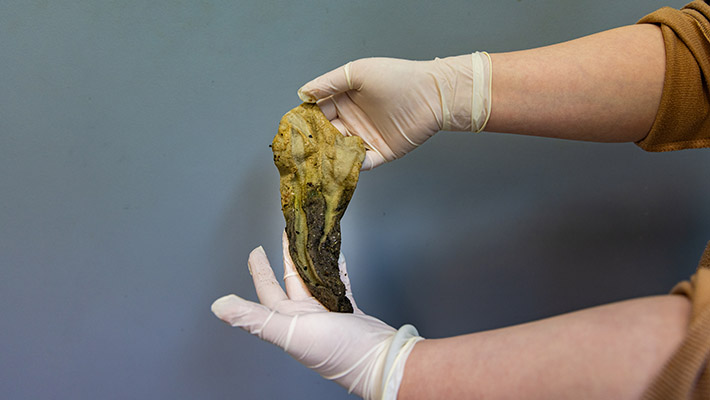Posted on 20th August 2024 by Media Relations

In a suburban backyard in Sydney, a peculiar sight sparked concern and curiosity — a Laughing Kookaburra found grounded and seemingly unwell. Known for its iconic call that mimics human laughter, the Kookaburra was found unusually quiet and still.
The bird was rescued by a WIRES volunteer and brought to Taronga Wildlife Hospital for examination. Initial assessments revealed that the Kookaburra, despite being in generally good condition, had laboured breathing and was emitting a foul smell from its mouth. The cause of its distress was, however, unclear.
The expert veterinary team at Taronga Wildlife Hospital were determined to get to the bottom of the mysterious illness. Under general anaesthesia, they conducted an x-ray, which revealed no obvious obstruction but only a faint tube-like outline inside the Kookaburra extending from the oesophagus. The exact nature of the obstruction continued to remained elusive.

While still under anaesthesia, the veterinary team carefully located a mass deep within the bird's oesophagus. To their astonishment, the offending item was not a natural prey or a common object found in the wild – but an adult-sized ankle sock!
The sock was successfully extracted using forceps, and the Kookaburra is now on the road to recovery and feeding well. It will continue to be monitored and once assessed to be at optimum health, released back to the wild.
This wildlife case is a reminder of the need to protect wildlife from the critical dangers of foreign debris ingestion in our shared spaces. For wildlife, ingesting non-food items can cause serious health issues, from choking and internal injuries to infections. Wildlife are particularly vulnerable to such hazards as they can mistake human-made items for food or become entangled in debris and litter, leading to potentially fatal consequences.
We can all play an active role in protecting wildlife by ensuring that litter and waste are properly disposed of. Here are a few things you can do to make a significant difference:
- Make Better Choices – We can all do our part to make better choices to help protect our beautiful wildlife, including by minimising waste, being mindful of how we dispose of items, and reduce reliance on single-use items
- Secure Trash – Ensure that all garbage and recycling containers are sealed and inaccessible to wildlife
- Clean Up Outdoors – If you see litter on the streets, in parks, along trails, and in natural habitats, pick it up and place it in appropriate bins to reduce the risk of wildlife encountering harmful debris
- Educate and Advocate – Speak to your friends and loved ones. The more we raise awareness about the dangers of waste to wildlife, the more we can help to protect our beautiful native species
This Kookaburra’s ordeal serves as a poignant reminder of the interconnectedness of human and wildlife environments. Every piece of litter not properly disposed of has the potential to affect the health and safety of animals living nearby. By taking proactive steps to reduce waste and prevent wildlife encounters with debris, we can help ensure that our shared spaces remain a safe haven for all inhabitants.
Whether you’re on land or at sea, if you come across injured wildlife and it is safe to do so, bring them into our Taronga Wildlife Hospital in Sydney or Dubbo, where they’ll be assessed and treated by our expert veterinary team.
Across both its sites at Sydney and Dubbo, Taronga’s two Wildlife Hospitals receive approximately 1,500 sick, injured or orphaned native animals for treatment and rehabilitation annually, and care for the more than 5000 animals that are onsite.
Taronga’s specialist veterinary teams work under enormous pressure to respond to the ever-increasing demand for veterinary and wildlife care services. To future-proof Australia’s wildlife, a new Wildlife Hospital will be built at Taronga Zoo Sydney and will increase our hospital team's capacity to treat and care for injured wildlife. The new Wildlife Hospital will also be a purpose-built teaching hospital, bringing to life Taronga’s ambitious vision to be NSW’s first state-of-the-art specialist teaching veterinary hospital, ensuring that succeeding generations of veterinarians and carers will be equipped with the knowledge and skills to continue protecting our unique environment.
Read more about Taronga’s new Wildlife Hospital here.
